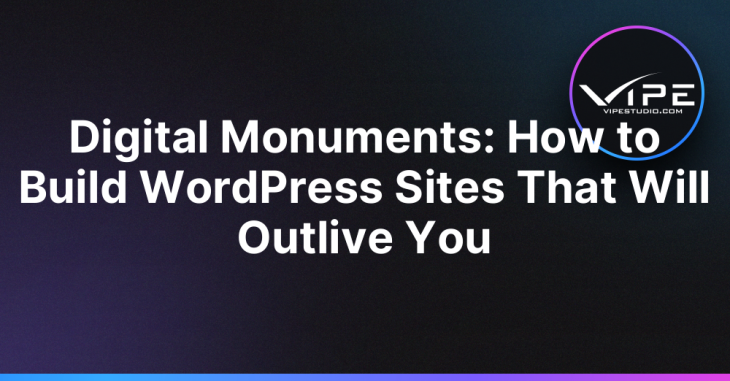Digital Monuments: How to Build WordPress Sites That Will Outlive You

READING TIME: MIN
Introduction: Thinking Beyond the Temporary
In an era defined by rapid turnover of websites, apps, and platforms, the notion of building something that will endure feels almost revolutionary. Yet the web has its own monuments—digital spaces that remain relevant and resilient long after their creators step away. WordPress, thanks to its open-source foundation and extensibility, is one of the most reliable tools for crafting such enduring projects. The challenge is not only technical; it requires rethinking design, content, and stewardship so that a site can remain useful and accessible for years, or even decades, to come.
WordPress as a Long-Term Platform
When WordPress first emerged, it was framed as a simple blogging tool. Over time, it evolved into a robust content management system and then a full-fledged application framework. Its longevity comes not from branding but from its open-source nature. By not relying on proprietary licensing models or closed ecosystems, WordPress guarantees that knowledge, themes, plugins, and core updates remain available. This open availability makes it uniquely suited for projects intended to serve as digital monuments—sites designed to stand the test of time.
For those seeking to preserve content for historical, academic, or cultural reasons, relying on a trusted ecosystem—sometimes through support from a WordPress agency—ensures the site’s foundation remains stable, regardless of shifting commercial trends.

Architecting for Digital Permanence
Longevity begins with intentional architecture. A site designed for endurance must prioritize clean code, minimal dependencies, and sustainable hosting. Bloated plugins or poorly maintained themes are fragile; they break as environments evolve. Instead, developers should build with clarity and restraint, prioritizing functionality that can be easily updated or replaced.
- Minimal plugin reliance: Reduce the number of third-party dependencies to limit points of failure.
- Standards-compliant code: Follow WordPress coding standards to ensure future compatibility.
- Robust backups: Automate versioned backups stored across multiple locations.
- Documentation: Write human-readable documentation to guide future maintainers.
Hosting as a Foundation of Permanence
Infrastructure often dictates whether a site survives or collapses. Hosting providers may disappear, but resilient strategies—cloud redundancy, containerization, or even static generation—help secure long-term presence. WordPress can be configured to serve statically cached content, reducing dependencies on dynamic processing while preserving interactivity through APIs. For projects meant to act as monuments, sustainability of hosting choices should be considered as carefully as the site’s content.
Content as the Core of Digital Legacy
Technology will evolve, but content is the essence of digital permanence. A site may outlive its creator not through dazzling features but through the value of its words, images, and archives. Clear organization, semantic structure, and open licensing ensure future relevance. Storing content in portable formats such as XML or JSON further ensures it can be migrated long after specific tools fade.

Think of digital monuments as archives of meaning: they must serve users across generations. In academic contexts, for example, WordPress sites hosting research projects or oral histories become digital repositories, persisting as long as content remains accessible and well-maintained.
Designing for Timelessness
Unlike trendy, ephemeral designs, a digital monument requires timeless aesthetics. Simplicity, clarity, and accessibility transcend design fads. Lightweight typography, balanced layouts, and careful use of color help ensure a site feels usable even decades later. Accessibility standards, including WCAG compliance, expand a site’s relevance by making it inclusive across devices and user needs.
Security and Maintenance as Preservation
Every monument is vulnerable to erosion, and in the digital realm, that erosion comes through attacks and neglect. To ensure longevity, sites must have clear maintenance plans: core updates, plugin auditing, and system monitoring. Just as physical monuments require caretakers, digital monuments require stewards. Even when creators move on, a framework for long-term guardianship is essential.

Many institutions ensure this through succession planning. In practice, this means designating future maintainers or collaborating with experts—sometimes consulting specialists in WordPress infrastructure—to ensure that the site’s preservation is not left to chance.
Archiving and Redundancy
True digital permanence involves redundancy. A site should not only exist on its live server but also in mirrored archives, offline storage, and institutional repositories. Tools like the Internet Archive’s Wayback Machine provide snapshots, but WordPress administrators can take ownership of redundancy by exporting content, storing static versions, and maintaining local copies.
Archiving is not a one-time action but a repeated ritual. Scheduled exports and structured backups extend the life of the monument, ensuring that even if one version is lost, another survives.

Case Studies in Digital Monuments
WordPress has already been used in long-term projects that demonstrate its suitability as a monument-building tool. Universities host archives of digitized manuscripts, NGOs maintain long-term campaign records, and local communities curate cultural histories. In each case, sustainability came not from flashy features but from disciplined design and clear stewardship practices.
Challenges of Digital Immortality
Despite best efforts, digital permanence is fragile. Hosting companies close, plugins become obsolete, and changing security protocols create new risks. The fragility of digital monuments reminds us that permanence is relative: the goal is resilience, not immortality. Yet the pursuit of resilience itself creates more durable structures, both technically and socially.
Conclusion: Building for the Future
A WordPress site that outlives its creator is more than just a website—it is a commitment to stewardship, resilience, and meaning. By minimizing dependencies, securing infrastructure, prioritizing timeless design, and archiving effectively, developers can craft sites that stand as monuments in the digital landscape. The question is not whether the site will last forever, but whether it will last long enough to matter. For those willing to take the long view, WordPress provides the scaffolding upon which enduring legacies can be built.

Key takeaways
- WordPress’s open-source nature makes it ideal for building long-term digital projects.
- Minimal dependencies, clear documentation, and clean code support longevity.
- Sustainable hosting and redundancy protect against obsolescence.
- Content, not features, is the true core of digital permanence.
- Security, maintenance, and stewardship ensure that sites endure over time.
- Digital monuments are not immortal but resilient enough to outlive their creators.
More on The Topic
- The WordPress Identity Crisis: Is It a Blog? A Framework? A Platform? A Feeling?
- The Developer Economy Is Broken: What We Really Sell Isn’t Code
- WordPress as a Resistance Tool: Building Digital Infrastructure for Rebellion
- Digital Garbage: The Ethics of Everything We Leave Behind
- The 48-Hour Website: What Happens When You Cut Every Corner on Purpose

